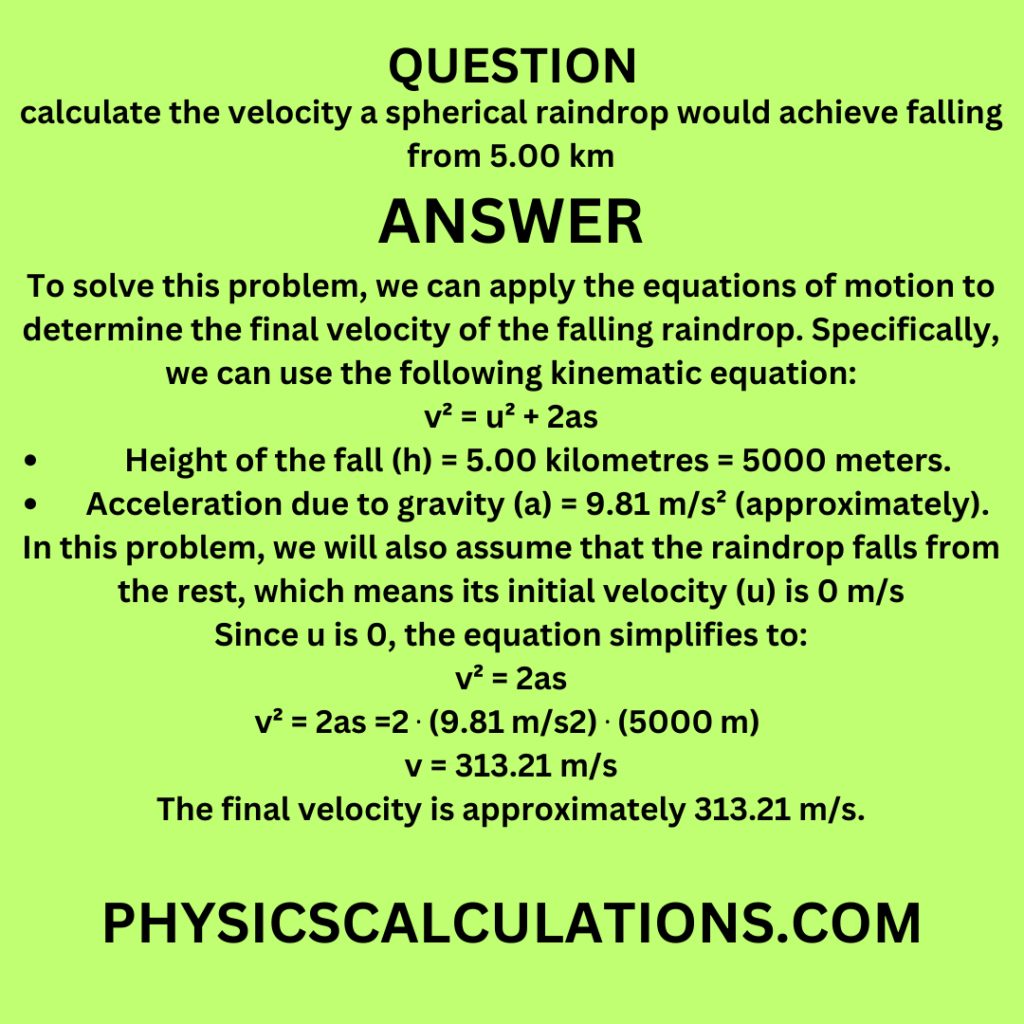Question
calculate the velocity a spherical raindrop would achieve falling from 5.00 km
Answer
The spherical raindrop falling from a height of 5.00 kilometres would achieve a final velocity of approximately 313.21 meters per second (m/s)

Learn: Kinematic Equations
Explanation
Our task is to calculate the velocity that a spherical raindrop would achieve when falling from a height of 5.00 kilometres.
Data: We have the following information:
- Height of the fall (h) = 5.00 kilometres.
Unknown: We need to find the velocity (v) = ?
Formula: To solve this problem, we can apply the equations of motion to determine the final velocity of the falling raindrop. Specifically, we can use the following kinematic equation:
v2 = u2 + 2as
Where:
- v is the final velocity.
- u is the initial velocity (which is usually 0 m/s in free fall from rest).
- a is the acceleration due to gravity.
- s is the displacement (in this case, the height from which the raindrop falls).
The acceleration due to gravity (a) is approximately 9.81 m/s² on Earth’s surface.
Solution:
First Step: We will begin by identifying the given data:
- Height of the fall (h) = 5.00 kilometres = 5000 meters.
- Acceleration due to gravity (a) = 9.81 m/s² (approximately).
Second Step: In this problem, we will also assume that the raindrop falls from the rest, which means its initial velocity (u) is 0 m/s.
Third Step: Now, we can use the kinematic equation to calculate the final velocity (v):
v2 = u2 + 2as
Since u is 0, the equation simplifies to:
v2 = 2as
Fourth Step: Substitute the values:
v2 = 2as =2⋅(9.81 m/s2)⋅(5000 m)
Fifth Step: Calculate the result:
v2 = 2as =2⋅(9.81 m/s2)⋅(5000 m)
Hence, v2 = 2⋅(9.81 m/s2)⋅(5000 m) =98,100 m2/s2
Sixth Step: Now, we need to find v by taking the square root of the result:
√v2 = √(98,100 m2/s2)
Seventh Step: Calculate the final velocity:
v = 313.21 m/s
Thus, v = 313.21 m/s
Eighth Step: The final velocity is approximately 313.21 m/s.
Explanation: The spherical raindrop falling from a height of 5.00 kilometers would achieve a final velocity of approximately 313.21 meters per second (m/s). This velocity is a result of the acceleration due to gravity pulling the raindrop downward.
In this problem, we used the equations of motion to calculate the final velocity, considering that the raindrop falls from rest. The acceleration due to gravity is a key factor in determining the velocity of objects in free fall.
Understanding the motion of objects under gravity is fundamental in physics and has applications in various fields, from meteorology to engineering. Raindrops, in particular, provide valuable insights into the behaviour of particles in the atmosphere and contribute to our understanding of precipitation processes.
In summary, the calculated final velocity of the spherical raindrop falling from a height of 5.00 kilometres is approximately 313.21 m/s, determined using the equations of motion and the acceleration due to gravity.